Strategic Analysis: ALDI's Expansion into New Zealand Market (RKC)
VerifiedAdded on 2023/06/15
|27
|5520
|171
Report
AI Summary
This report assesses the feasibility of ALDI's expansion into the New Zealand market. It begins with an overview of ALDI's global presence and rationale for selecting New Zealand as a potential market, supported by a comparative PESTLE analysis against the Czech Republic. The analysis delves into New Zealand's political, economic, social, technological, legal, and environmental factors, followed by an application of Porter's Five Forces to evaluate the competitive landscape, including supplier power, new entrant threats, buyer power, substitute threats, and competitive rivalry. The report also outlines ALDI's value chain, distinguishing between primary and support activities, and suggests suitable market entry modes with justifications. The conclusion summarizes the key findings and recommendations for ALDI's successful entry into the New Zealand market. Desklib provides similar solved assignments and past papers for students.
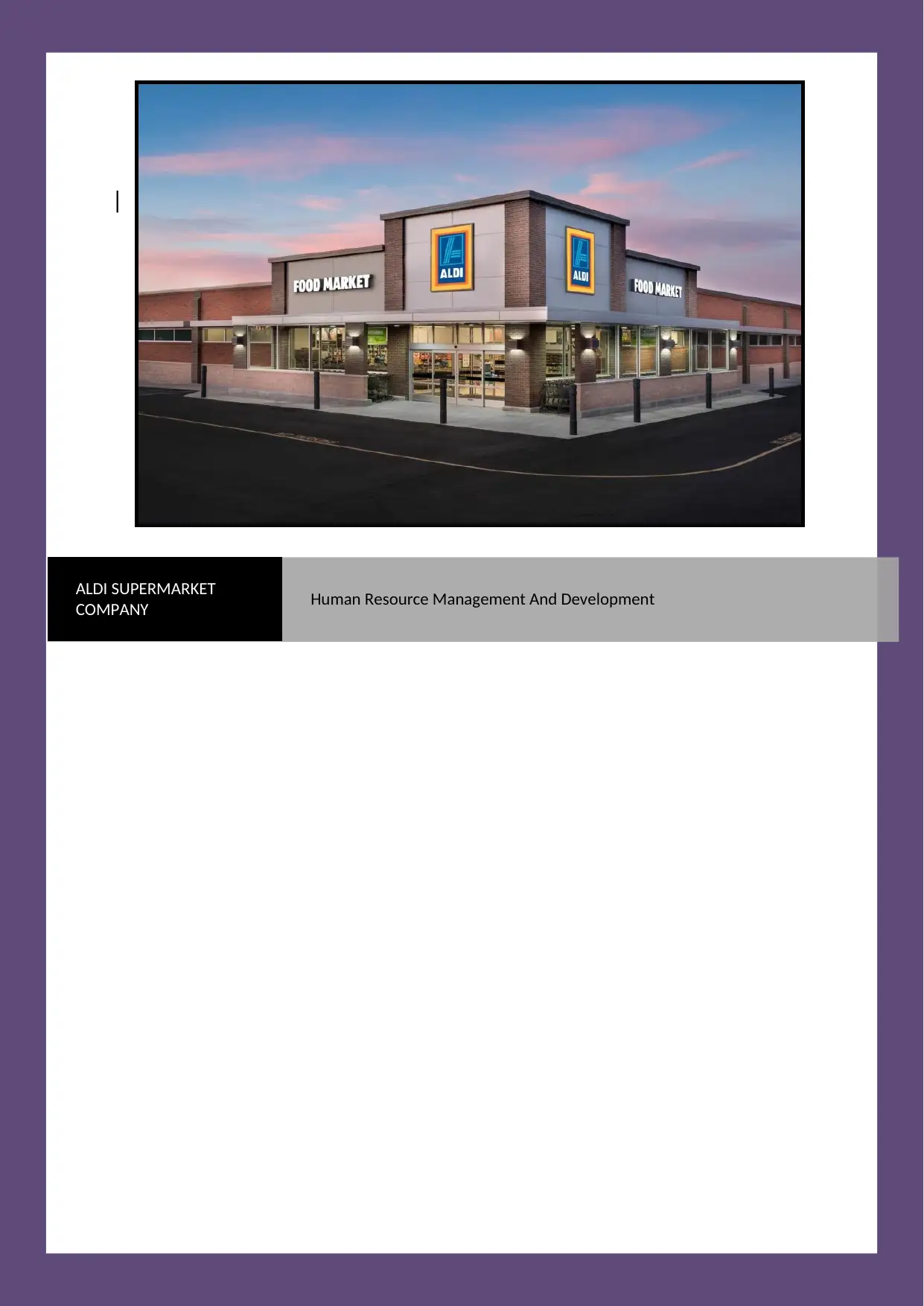
|
ALDI SUPERMARKET
COMPANY Human Resource Management And Development
ALDI SUPERMARKET
COMPANY Human Resource Management And Development
Paraphrase This Document
Need a fresh take? Get an instant paraphrase of this document with our AI Paraphraser
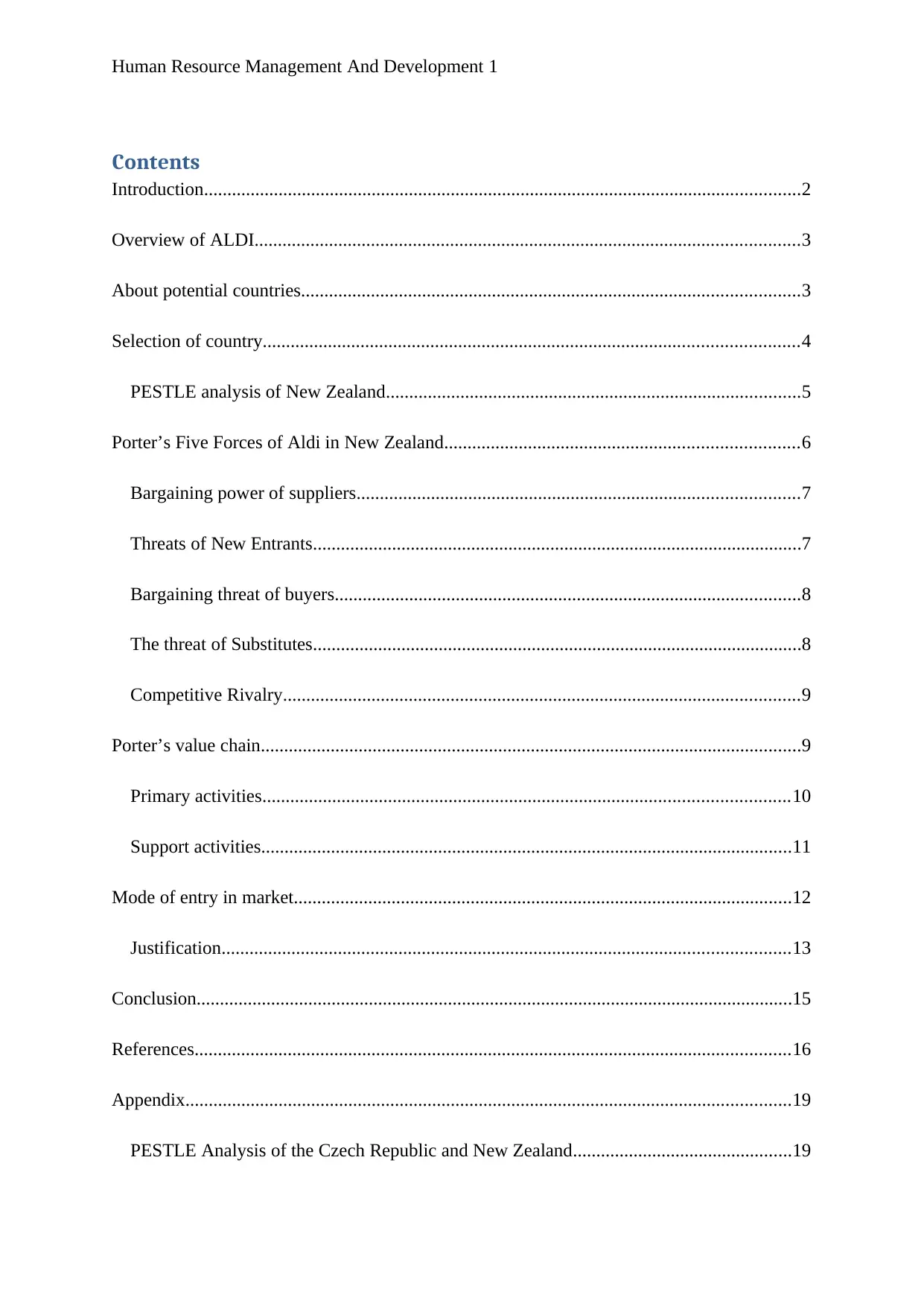
Human Resource Management And Development 1
Contents
Introduction................................................................................................................................2
Overview of ALDI.....................................................................................................................3
About potential countries...........................................................................................................3
Selection of country...................................................................................................................4
PESTLE analysis of New Zealand.........................................................................................5
Porter’s Five Forces of Aldi in New Zealand............................................................................6
Bargaining power of suppliers...............................................................................................7
Threats of New Entrants.........................................................................................................7
Bargaining threat of buyers....................................................................................................8
The threat of Substitutes.........................................................................................................8
Competitive Rivalry...............................................................................................................9
Porter’s value chain....................................................................................................................9
Primary activities.................................................................................................................10
Support activities..................................................................................................................11
Mode of entry in market...........................................................................................................12
Justification..........................................................................................................................13
Conclusion................................................................................................................................15
References................................................................................................................................16
Appendix..................................................................................................................................19
PESTLE Analysis of the Czech Republic and New Zealand...............................................19
Contents
Introduction................................................................................................................................2
Overview of ALDI.....................................................................................................................3
About potential countries...........................................................................................................3
Selection of country...................................................................................................................4
PESTLE analysis of New Zealand.........................................................................................5
Porter’s Five Forces of Aldi in New Zealand............................................................................6
Bargaining power of suppliers...............................................................................................7
Threats of New Entrants.........................................................................................................7
Bargaining threat of buyers....................................................................................................8
The threat of Substitutes.........................................................................................................8
Competitive Rivalry...............................................................................................................9
Porter’s value chain....................................................................................................................9
Primary activities.................................................................................................................10
Support activities..................................................................................................................11
Mode of entry in market...........................................................................................................12
Justification..........................................................................................................................13
Conclusion................................................................................................................................15
References................................................................................................................................16
Appendix..................................................................................................................................19
PESTLE Analysis of the Czech Republic and New Zealand...............................................19
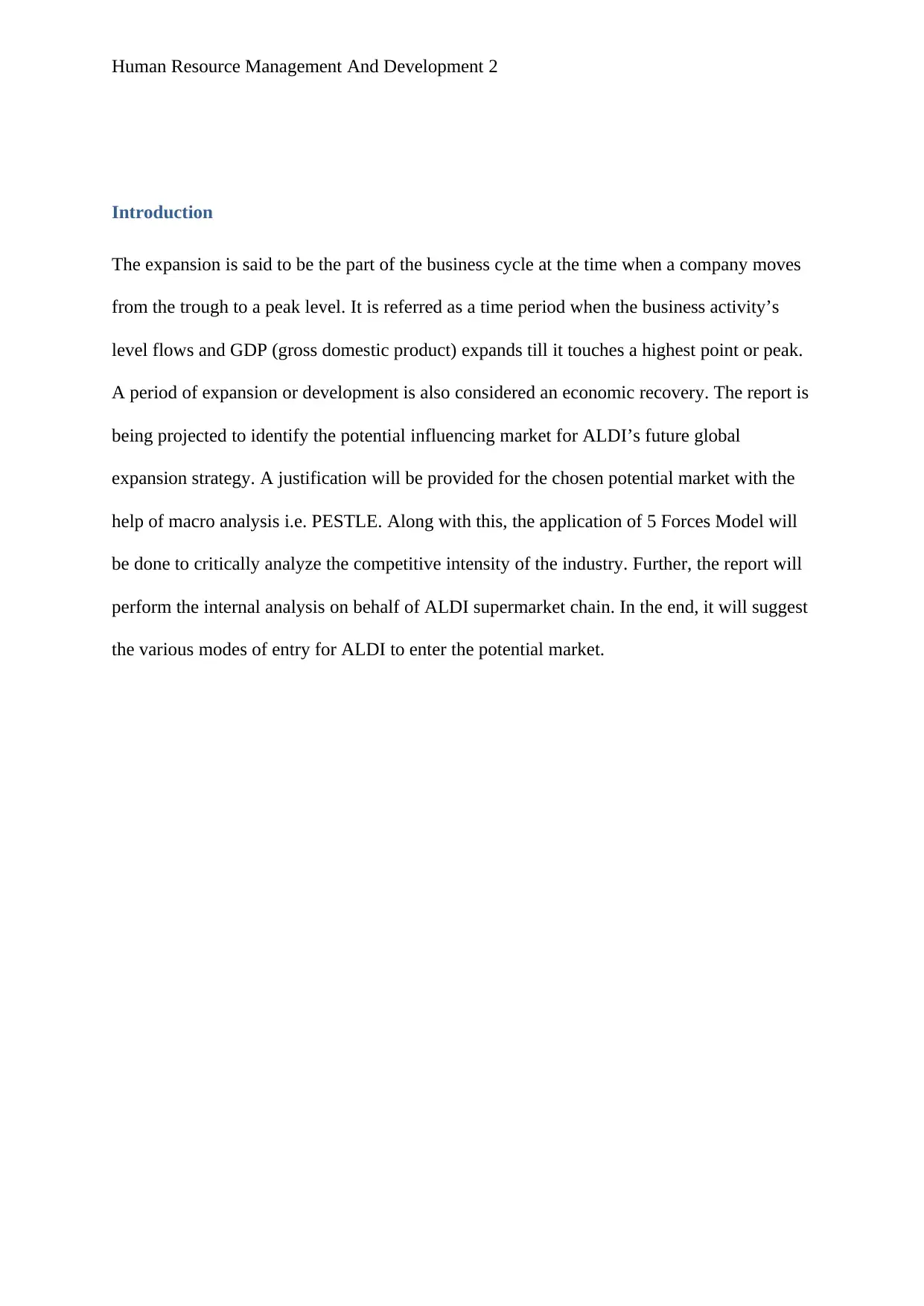
Human Resource Management And Development 2
Introduction
The expansion is said to be the part of the business cycle at the time when a company moves
from the trough to a peak level. It is referred as a time period when the business activity’s
level flows and GDP (gross domestic product) expands till it touches a highest point or peak.
A period of expansion or development is also considered an economic recovery. The report is
being projected to identify the potential influencing market for ALDI’s future global
expansion strategy. A justification will be provided for the chosen potential market with the
help of macro analysis i.e. PESTLE. Along with this, the application of 5 Forces Model will
be done to critically analyze the competitive intensity of the industry. Further, the report will
perform the internal analysis on behalf of ALDI supermarket chain. In the end, it will suggest
the various modes of entry for ALDI to enter the potential market.
Introduction
The expansion is said to be the part of the business cycle at the time when a company moves
from the trough to a peak level. It is referred as a time period when the business activity’s
level flows and GDP (gross domestic product) expands till it touches a highest point or peak.
A period of expansion or development is also considered an economic recovery. The report is
being projected to identify the potential influencing market for ALDI’s future global
expansion strategy. A justification will be provided for the chosen potential market with the
help of macro analysis i.e. PESTLE. Along with this, the application of 5 Forces Model will
be done to critically analyze the competitive intensity of the industry. Further, the report will
perform the internal analysis on behalf of ALDI supermarket chain. In the end, it will suggest
the various modes of entry for ALDI to enter the potential market.
⊘ This is a preview!⊘
Do you want full access?
Subscribe today to unlock all pages.

Trusted by 1+ million students worldwide
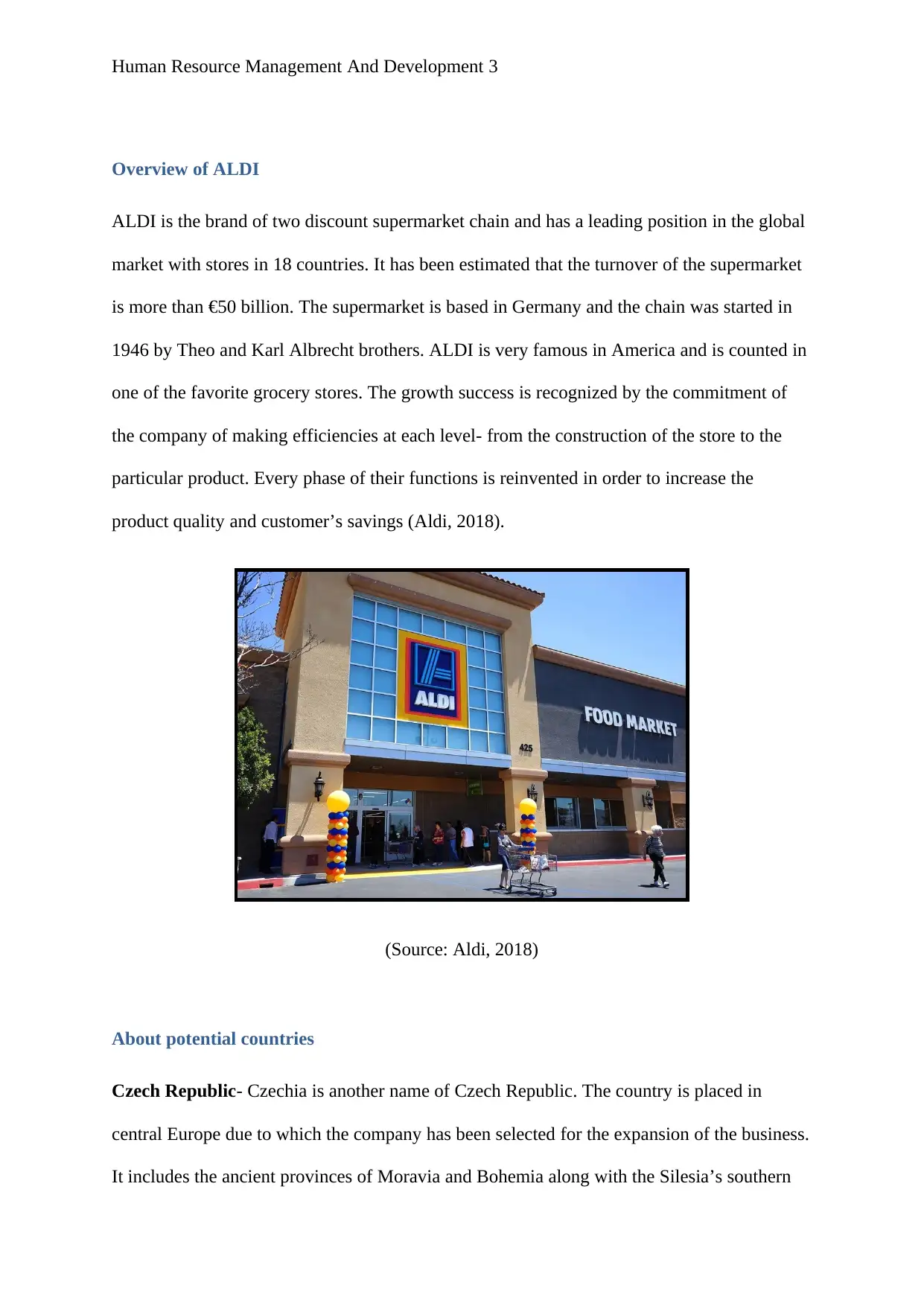
Human Resource Management And Development 3
Overview of ALDI
ALDI is the brand of two discount supermarket chain and has a leading position in the global
market with stores in 18 countries. It has been estimated that the turnover of the supermarket
is more than €50 billion. The supermarket is based in Germany and the chain was started in
1946 by Theo and Karl Albrecht brothers. ALDI is very famous in America and is counted in
one of the favorite grocery stores. The growth success is recognized by the commitment of
the company of making efficiencies at each level- from the construction of the store to the
particular product. Every phase of their functions is reinvented in order to increase the
product quality and customer’s savings (Aldi, 2018).
(Source: Aldi, 2018)
About potential countries
Czech Republic- Czechia is another name of Czech Republic. The country is placed in
central Europe due to which the company has been selected for the expansion of the business.
It includes the ancient provinces of Moravia and Bohemia along with the Silesia’s southern
Overview of ALDI
ALDI is the brand of two discount supermarket chain and has a leading position in the global
market with stores in 18 countries. It has been estimated that the turnover of the supermarket
is more than €50 billion. The supermarket is based in Germany and the chain was started in
1946 by Theo and Karl Albrecht brothers. ALDI is very famous in America and is counted in
one of the favorite grocery stores. The growth success is recognized by the commitment of
the company of making efficiencies at each level- from the construction of the store to the
particular product. Every phase of their functions is reinvented in order to increase the
product quality and customer’s savings (Aldi, 2018).
(Source: Aldi, 2018)
About potential countries
Czech Republic- Czechia is another name of Czech Republic. The country is placed in
central Europe due to which the company has been selected for the expansion of the business.
It includes the ancient provinces of Moravia and Bohemia along with the Silesia’s southern
Paraphrase This Document
Need a fresh take? Get an instant paraphrase of this document with our AI Paraphraser
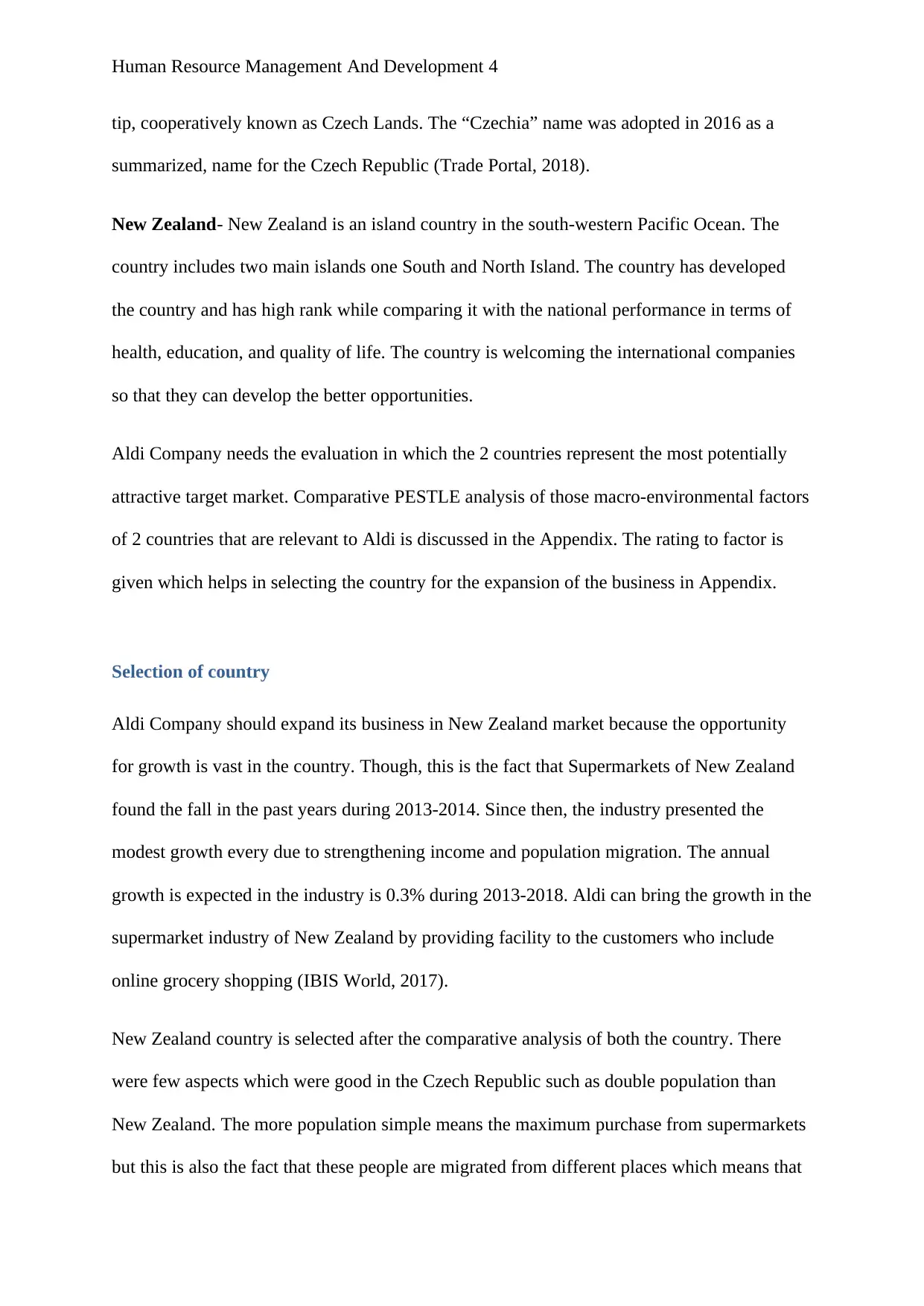
Human Resource Management And Development 4
tip, cooperatively known as Czech Lands. The “Czechia” name was adopted in 2016 as a
summarized, name for the Czech Republic (Trade Portal, 2018).
New Zealand- New Zealand is an island country in the south-western Pacific Ocean. The
country includes two main islands one South and North Island. The country has developed
the country and has high rank while comparing it with the national performance in terms of
health, education, and quality of life. The country is welcoming the international companies
so that they can develop the better opportunities.
Aldi Company needs the evaluation in which the 2 countries represent the most potentially
attractive target market. Comparative PESTLE analysis of those macro-environmental factors
of 2 countries that are relevant to Aldi is discussed in the Appendix. The rating to factor is
given which helps in selecting the country for the expansion of the business in Appendix.
Selection of country
Aldi Company should expand its business in New Zealand market because the opportunity
for growth is vast in the country. Though, this is the fact that Supermarkets of New Zealand
found the fall in the past years during 2013-2014. Since then, the industry presented the
modest growth every due to strengthening income and population migration. The annual
growth is expected in the industry is 0.3% during 2013-2018. Aldi can bring the growth in the
supermarket industry of New Zealand by providing facility to the customers who include
online grocery shopping (IBIS World, 2017).
New Zealand country is selected after the comparative analysis of both the country. There
were few aspects which were good in the Czech Republic such as double population than
New Zealand. The more population simple means the maximum purchase from supermarkets
but this is also the fact that these people are migrated from different places which means that
tip, cooperatively known as Czech Lands. The “Czechia” name was adopted in 2016 as a
summarized, name for the Czech Republic (Trade Portal, 2018).
New Zealand- New Zealand is an island country in the south-western Pacific Ocean. The
country includes two main islands one South and North Island. The country has developed
the country and has high rank while comparing it with the national performance in terms of
health, education, and quality of life. The country is welcoming the international companies
so that they can develop the better opportunities.
Aldi Company needs the evaluation in which the 2 countries represent the most potentially
attractive target market. Comparative PESTLE analysis of those macro-environmental factors
of 2 countries that are relevant to Aldi is discussed in the Appendix. The rating to factor is
given which helps in selecting the country for the expansion of the business in Appendix.
Selection of country
Aldi Company should expand its business in New Zealand market because the opportunity
for growth is vast in the country. Though, this is the fact that Supermarkets of New Zealand
found the fall in the past years during 2013-2014. Since then, the industry presented the
modest growth every due to strengthening income and population migration. The annual
growth is expected in the industry is 0.3% during 2013-2018. Aldi can bring the growth in the
supermarket industry of New Zealand by providing facility to the customers who include
online grocery shopping (IBIS World, 2017).
New Zealand country is selected after the comparative analysis of both the country. There
were few aspects which were good in the Czech Republic such as double population than
New Zealand. The more population simple means the maximum purchase from supermarkets
but this is also the fact that these people are migrated from different places which means that
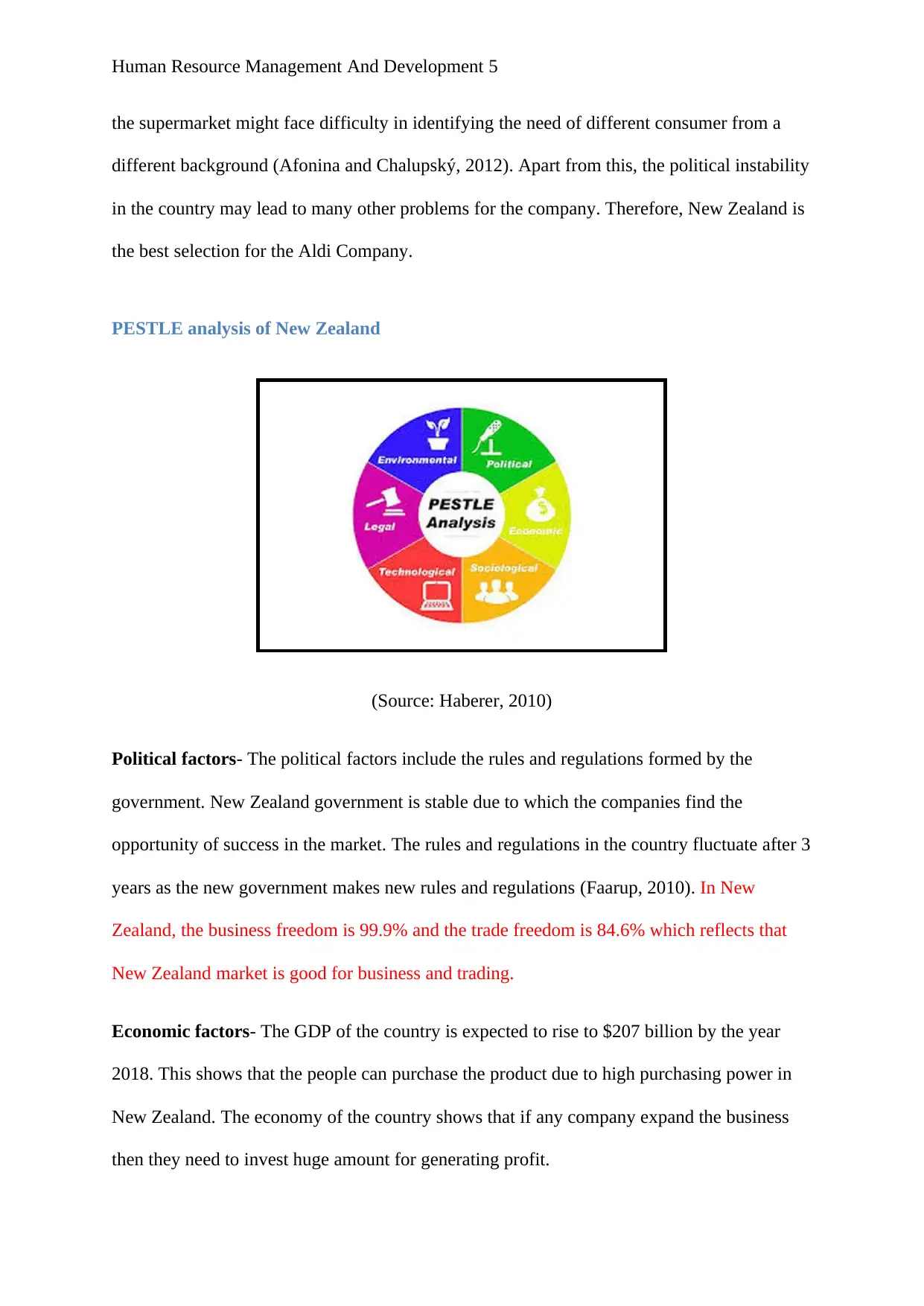
Human Resource Management And Development 5
the supermarket might face difficulty in identifying the need of different consumer from a
different background (Afonina and Chalupský, 2012). Apart from this, the political instability
in the country may lead to many other problems for the company. Therefore, New Zealand is
the best selection for the Aldi Company.
PESTLE analysis of New Zealand
(Source: Haberer, 2010)
Political factors- The political factors include the rules and regulations formed by the
government. New Zealand government is stable due to which the companies find the
opportunity of success in the market. The rules and regulations in the country fluctuate after 3
years as the new government makes new rules and regulations (Faarup, 2010). In New
Zealand, the business freedom is 99.9% and the trade freedom is 84.6% which reflects that
New Zealand market is good for business and trading.
Economic factors- The GDP of the country is expected to rise to $207 billion by the year
2018. This shows that the people can purchase the product due to high purchasing power in
New Zealand. The economy of the country shows that if any company expand the business
then they need to invest huge amount for generating profit.
the supermarket might face difficulty in identifying the need of different consumer from a
different background (Afonina and Chalupský, 2012). Apart from this, the political instability
in the country may lead to many other problems for the company. Therefore, New Zealand is
the best selection for the Aldi Company.
PESTLE analysis of New Zealand
(Source: Haberer, 2010)
Political factors- The political factors include the rules and regulations formed by the
government. New Zealand government is stable due to which the companies find the
opportunity of success in the market. The rules and regulations in the country fluctuate after 3
years as the new government makes new rules and regulations (Faarup, 2010). In New
Zealand, the business freedom is 99.9% and the trade freedom is 84.6% which reflects that
New Zealand market is good for business and trading.
Economic factors- The GDP of the country is expected to rise to $207 billion by the year
2018. This shows that the people can purchase the product due to high purchasing power in
New Zealand. The economy of the country shows that if any company expand the business
then they need to invest huge amount for generating profit.
⊘ This is a preview!⊘
Do you want full access?
Subscribe today to unlock all pages.

Trusted by 1+ million students worldwide
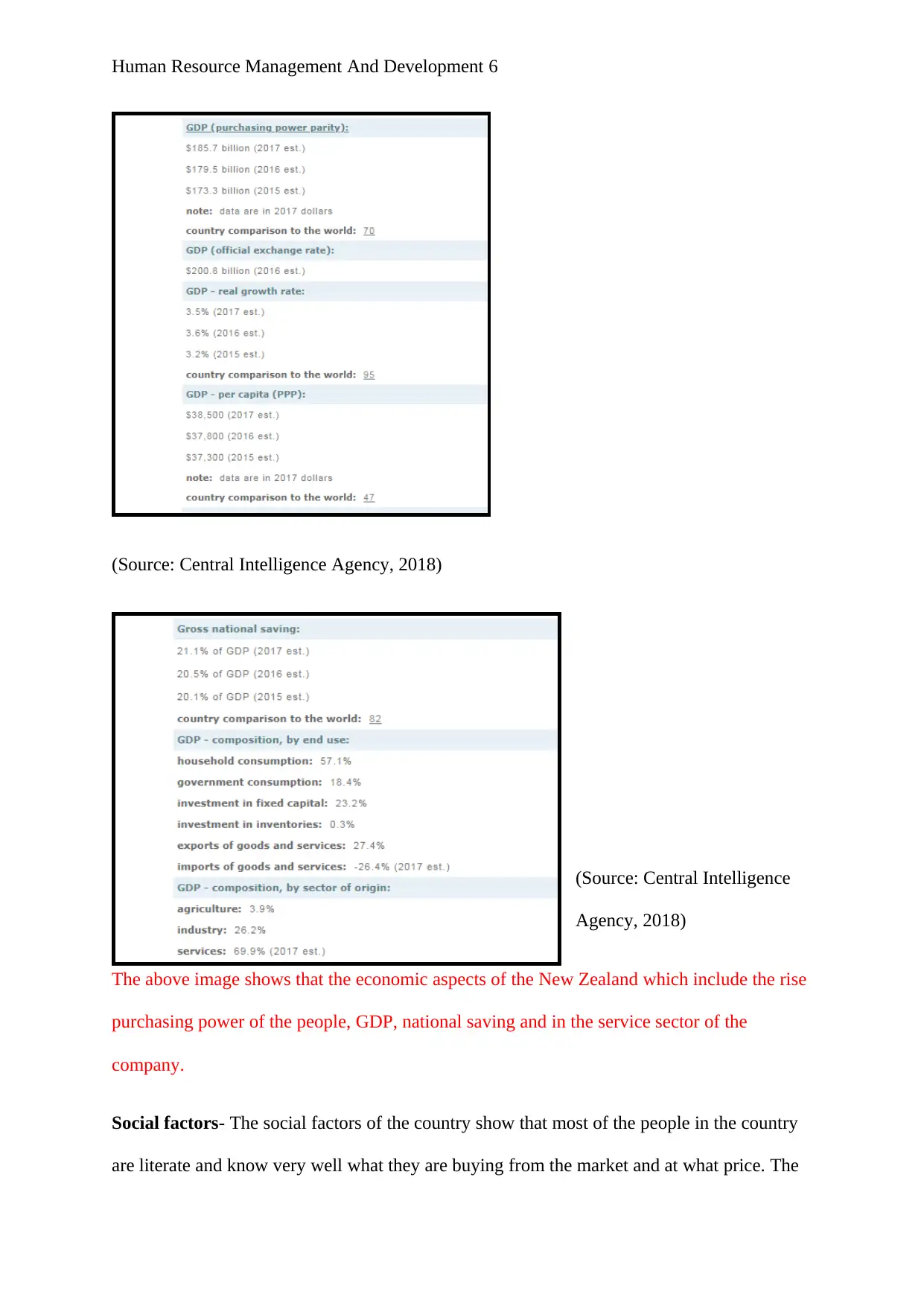
Human Resource Management And Development 6
(Source: Central Intelligence Agency, 2018)
(Source: Central Intelligence
Agency, 2018)
The above image shows that the economic aspects of the New Zealand which include the rise
purchasing power of the people, GDP, national saving and in the service sector of the
company.
Social factors- The social factors of the country show that most of the people in the country
are literate and know very well what they are buying from the market and at what price. The
(Source: Central Intelligence Agency, 2018)
(Source: Central Intelligence
Agency, 2018)
The above image shows that the economic aspects of the New Zealand which include the rise
purchasing power of the people, GDP, national saving and in the service sector of the
company.
Social factors- The social factors of the country show that most of the people in the country
are literate and know very well what they are buying from the market and at what price. The
Paraphrase This Document
Need a fresh take? Get an instant paraphrase of this document with our AI Paraphraser
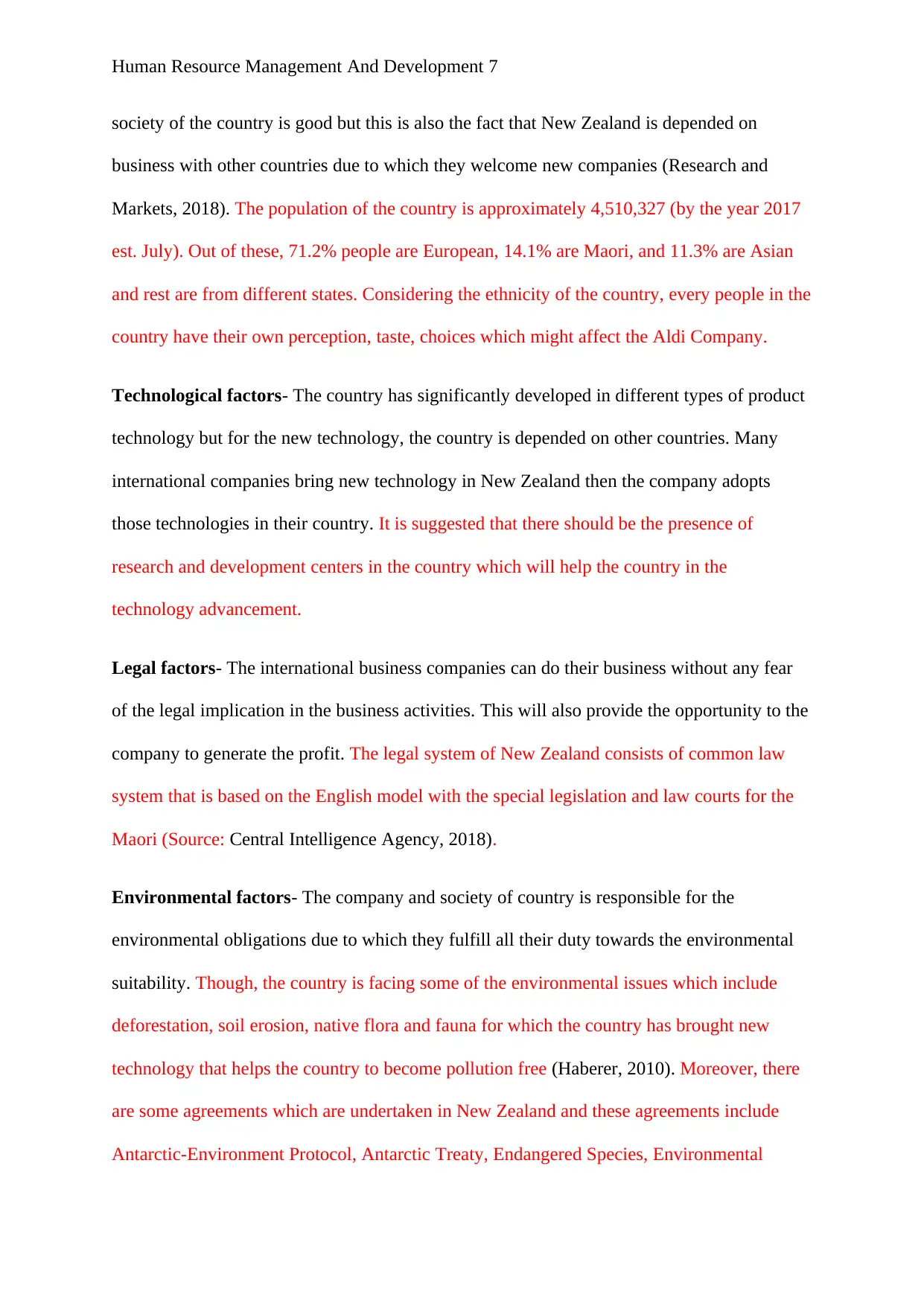
Human Resource Management And Development 7
society of the country is good but this is also the fact that New Zealand is depended on
business with other countries due to which they welcome new companies (Research and
Markets, 2018). The population of the country is approximately 4,510,327 (by the year 2017
est. July). Out of these, 71.2% people are European, 14.1% are Maori, and 11.3% are Asian
and rest are from different states. Considering the ethnicity of the country, every people in the
country have their own perception, taste, choices which might affect the Aldi Company.
Technological factors- The country has significantly developed in different types of product
technology but for the new technology, the country is depended on other countries. Many
international companies bring new technology in New Zealand then the company adopts
those technologies in their country. It is suggested that there should be the presence of
research and development centers in the country which will help the country in the
technology advancement.
Legal factors- The international business companies can do their business without any fear
of the legal implication in the business activities. This will also provide the opportunity to the
company to generate the profit. The legal system of New Zealand consists of common law
system that is based on the English model with the special legislation and law courts for the
Maori (Source: Central Intelligence Agency, 2018).
Environmental factors- The company and society of country is responsible for the
environmental obligations due to which they fulfill all their duty towards the environmental
suitability. Though, the country is facing some of the environmental issues which include
deforestation, soil erosion, native flora and fauna for which the country has brought new
technology that helps the country to become pollution free (Haberer, 2010). Moreover, there
are some agreements which are undertaken in New Zealand and these agreements include
Antarctic-Environment Protocol, Antarctic Treaty, Endangered Species, Environmental
society of the country is good but this is also the fact that New Zealand is depended on
business with other countries due to which they welcome new companies (Research and
Markets, 2018). The population of the country is approximately 4,510,327 (by the year 2017
est. July). Out of these, 71.2% people are European, 14.1% are Maori, and 11.3% are Asian
and rest are from different states. Considering the ethnicity of the country, every people in the
country have their own perception, taste, choices which might affect the Aldi Company.
Technological factors- The country has significantly developed in different types of product
technology but for the new technology, the country is depended on other countries. Many
international companies bring new technology in New Zealand then the company adopts
those technologies in their country. It is suggested that there should be the presence of
research and development centers in the country which will help the country in the
technology advancement.
Legal factors- The international business companies can do their business without any fear
of the legal implication in the business activities. This will also provide the opportunity to the
company to generate the profit. The legal system of New Zealand consists of common law
system that is based on the English model with the special legislation and law courts for the
Maori (Source: Central Intelligence Agency, 2018).
Environmental factors- The company and society of country is responsible for the
environmental obligations due to which they fulfill all their duty towards the environmental
suitability. Though, the country is facing some of the environmental issues which include
deforestation, soil erosion, native flora and fauna for which the country has brought new
technology that helps the country to become pollution free (Haberer, 2010). Moreover, there
are some agreements which are undertaken in New Zealand and these agreements include
Antarctic-Environment Protocol, Antarctic Treaty, Endangered Species, Environmental
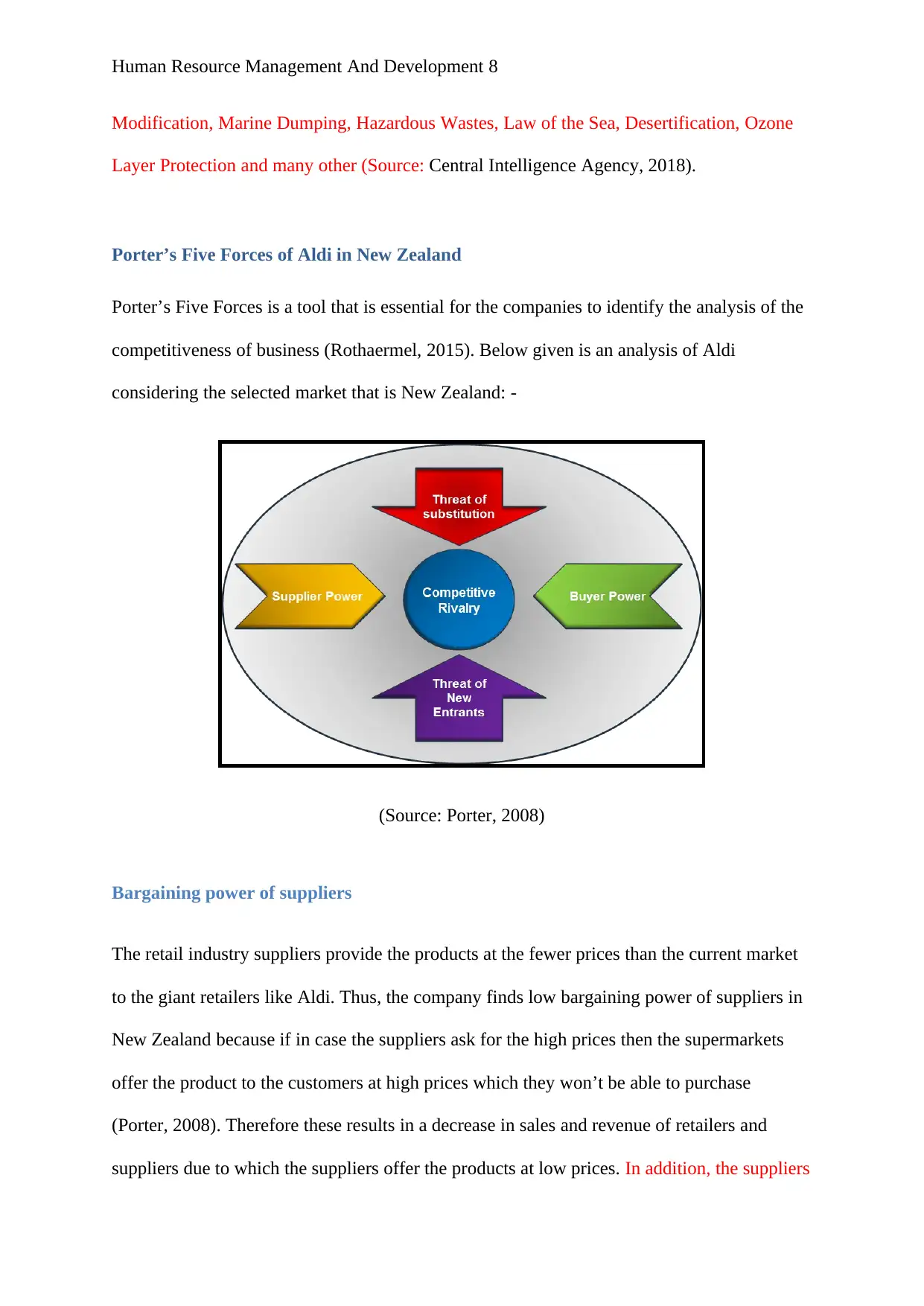
Human Resource Management And Development 8
Modification, Marine Dumping, Hazardous Wastes, Law of the Sea, Desertification, Ozone
Layer Protection and many other (Source: Central Intelligence Agency, 2018).
Porter’s Five Forces of Aldi in New Zealand
Porter’s Five Forces is a tool that is essential for the companies to identify the analysis of the
competitiveness of business (Rothaermel, 2015). Below given is an analysis of Aldi
considering the selected market that is New Zealand: -
(Source: Porter, 2008)
Bargaining power of suppliers
The retail industry suppliers provide the products at the fewer prices than the current market
to the giant retailers like Aldi. Thus, the company finds low bargaining power of suppliers in
New Zealand because if in case the suppliers ask for the high prices then the supermarkets
offer the product to the customers at high prices which they won’t be able to purchase
(Porter, 2008). Therefore these results in a decrease in sales and revenue of retailers and
suppliers due to which the suppliers offer the products at low prices. In addition, the suppliers
Modification, Marine Dumping, Hazardous Wastes, Law of the Sea, Desertification, Ozone
Layer Protection and many other (Source: Central Intelligence Agency, 2018).
Porter’s Five Forces of Aldi in New Zealand
Porter’s Five Forces is a tool that is essential for the companies to identify the analysis of the
competitiveness of business (Rothaermel, 2015). Below given is an analysis of Aldi
considering the selected market that is New Zealand: -
(Source: Porter, 2008)
Bargaining power of suppliers
The retail industry suppliers provide the products at the fewer prices than the current market
to the giant retailers like Aldi. Thus, the company finds low bargaining power of suppliers in
New Zealand because if in case the suppliers ask for the high prices then the supermarkets
offer the product to the customers at high prices which they won’t be able to purchase
(Porter, 2008). Therefore these results in a decrease in sales and revenue of retailers and
suppliers due to which the suppliers offer the products at low prices. In addition, the suppliers
⊘ This is a preview!⊘
Do you want full access?
Subscribe today to unlock all pages.

Trusted by 1+ million students worldwide
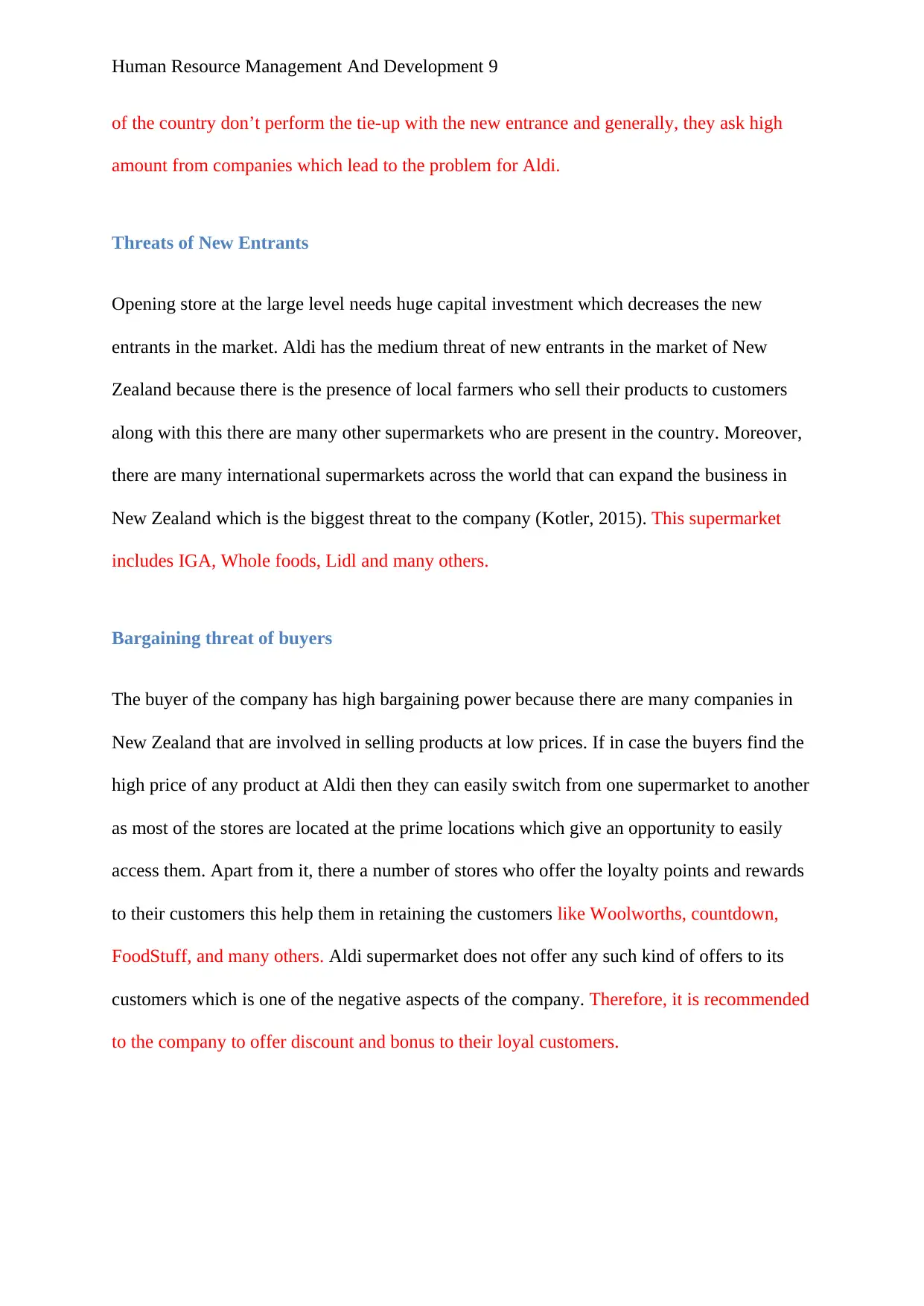
Human Resource Management And Development 9
of the country don’t perform the tie-up with the new entrance and generally, they ask high
amount from companies which lead to the problem for Aldi.
Threats of New Entrants
Opening store at the large level needs huge capital investment which decreases the new
entrants in the market. Aldi has the medium threat of new entrants in the market of New
Zealand because there is the presence of local farmers who sell their products to customers
along with this there are many other supermarkets who are present in the country. Moreover,
there are many international supermarkets across the world that can expand the business in
New Zealand which is the biggest threat to the company (Kotler, 2015). This supermarket
includes IGA, Whole foods, Lidl and many others.
Bargaining threat of buyers
The buyer of the company has high bargaining power because there are many companies in
New Zealand that are involved in selling products at low prices. If in case the buyers find the
high price of any product at Aldi then they can easily switch from one supermarket to another
as most of the stores are located at the prime locations which give an opportunity to easily
access them. Apart from it, there a number of stores who offer the loyalty points and rewards
to their customers this help them in retaining the customers like Woolworths, countdown,
FoodStuff, and many others. Aldi supermarket does not offer any such kind of offers to its
customers which is one of the negative aspects of the company. Therefore, it is recommended
to the company to offer discount and bonus to their loyal customers.
of the country don’t perform the tie-up with the new entrance and generally, they ask high
amount from companies which lead to the problem for Aldi.
Threats of New Entrants
Opening store at the large level needs huge capital investment which decreases the new
entrants in the market. Aldi has the medium threat of new entrants in the market of New
Zealand because there is the presence of local farmers who sell their products to customers
along with this there are many other supermarkets who are present in the country. Moreover,
there are many international supermarkets across the world that can expand the business in
New Zealand which is the biggest threat to the company (Kotler, 2015). This supermarket
includes IGA, Whole foods, Lidl and many others.
Bargaining threat of buyers
The buyer of the company has high bargaining power because there are many companies in
New Zealand that are involved in selling products at low prices. If in case the buyers find the
high price of any product at Aldi then they can easily switch from one supermarket to another
as most of the stores are located at the prime locations which give an opportunity to easily
access them. Apart from it, there a number of stores who offer the loyalty points and rewards
to their customers this help them in retaining the customers like Woolworths, countdown,
FoodStuff, and many others. Aldi supermarket does not offer any such kind of offers to its
customers which is one of the negative aspects of the company. Therefore, it is recommended
to the company to offer discount and bonus to their loyal customers.
Paraphrase This Document
Need a fresh take? Get an instant paraphrase of this document with our AI Paraphraser
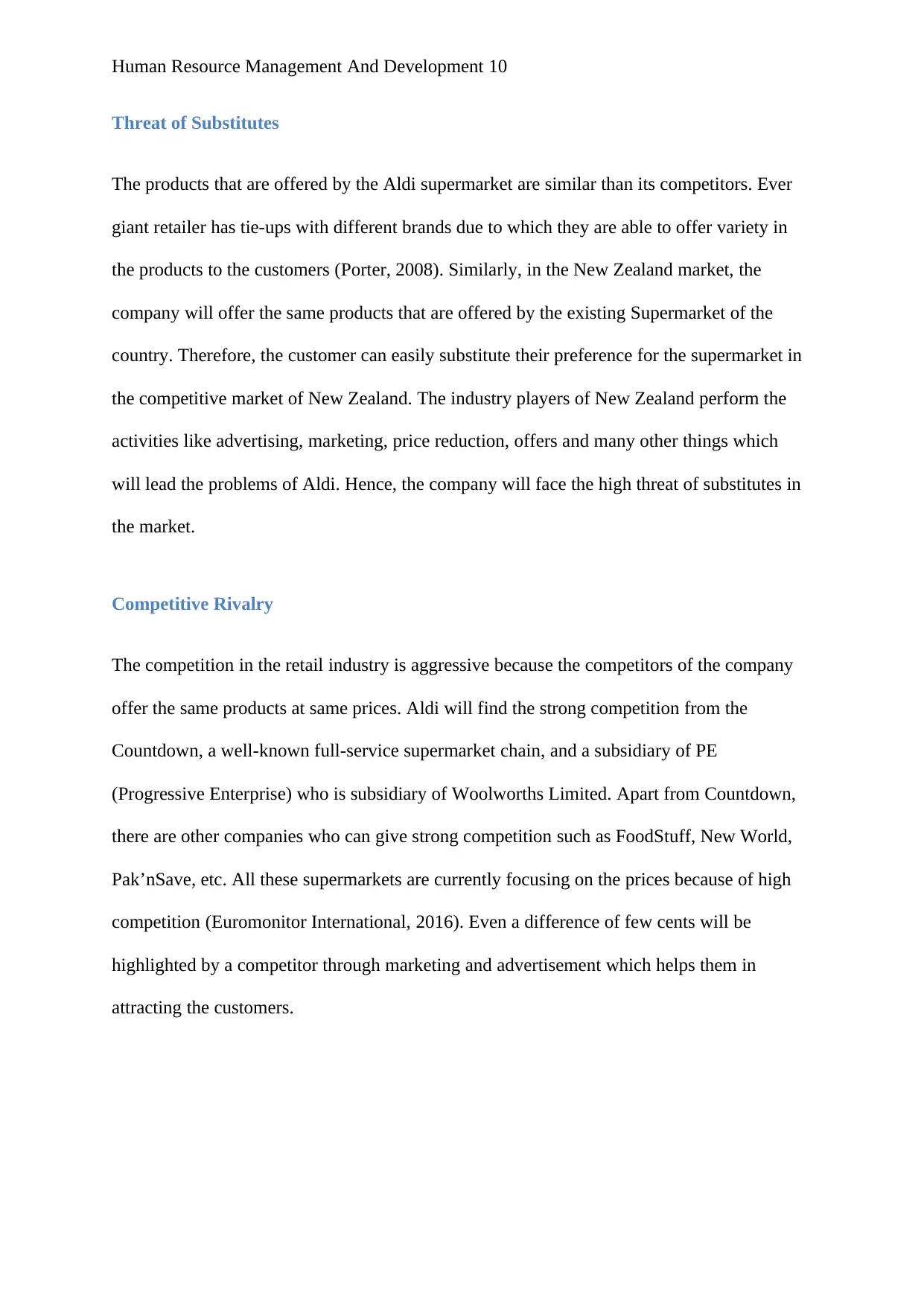
Human Resource Management And Development 10
Threat of Substitutes
The products that are offered by the Aldi supermarket are similar than its competitors. Ever
giant retailer has tie-ups with different brands due to which they are able to offer variety in
the products to the customers (Porter, 2008). Similarly, in the New Zealand market, the
company will offer the same products that are offered by the existing Supermarket of the
country. Therefore, the customer can easily substitute their preference for the supermarket in
the competitive market of New Zealand. The industry players of New Zealand perform the
activities like advertising, marketing, price reduction, offers and many other things which
will lead the problems of Aldi. Hence, the company will face the high threat of substitutes in
the market.
Competitive Rivalry
The competition in the retail industry is aggressive because the competitors of the company
offer the same products at same prices. Aldi will find the strong competition from the
Countdown, a well-known full-service supermarket chain, and a subsidiary of PE
(Progressive Enterprise) who is subsidiary of Woolworths Limited. Apart from Countdown,
there are other companies who can give strong competition such as FoodStuff, New World,
Pak’nSave, etc. All these supermarkets are currently focusing on the prices because of high
competition (Euromonitor International, 2016). Even a difference of few cents will be
highlighted by a competitor through marketing and advertisement which helps them in
attracting the customers.
Threat of Substitutes
The products that are offered by the Aldi supermarket are similar than its competitors. Ever
giant retailer has tie-ups with different brands due to which they are able to offer variety in
the products to the customers (Porter, 2008). Similarly, in the New Zealand market, the
company will offer the same products that are offered by the existing Supermarket of the
country. Therefore, the customer can easily substitute their preference for the supermarket in
the competitive market of New Zealand. The industry players of New Zealand perform the
activities like advertising, marketing, price reduction, offers and many other things which
will lead the problems of Aldi. Hence, the company will face the high threat of substitutes in
the market.
Competitive Rivalry
The competition in the retail industry is aggressive because the competitors of the company
offer the same products at same prices. Aldi will find the strong competition from the
Countdown, a well-known full-service supermarket chain, and a subsidiary of PE
(Progressive Enterprise) who is subsidiary of Woolworths Limited. Apart from Countdown,
there are other companies who can give strong competition such as FoodStuff, New World,
Pak’nSave, etc. All these supermarkets are currently focusing on the prices because of high
competition (Euromonitor International, 2016). Even a difference of few cents will be
highlighted by a competitor through marketing and advertisement which helps them in
attracting the customers.
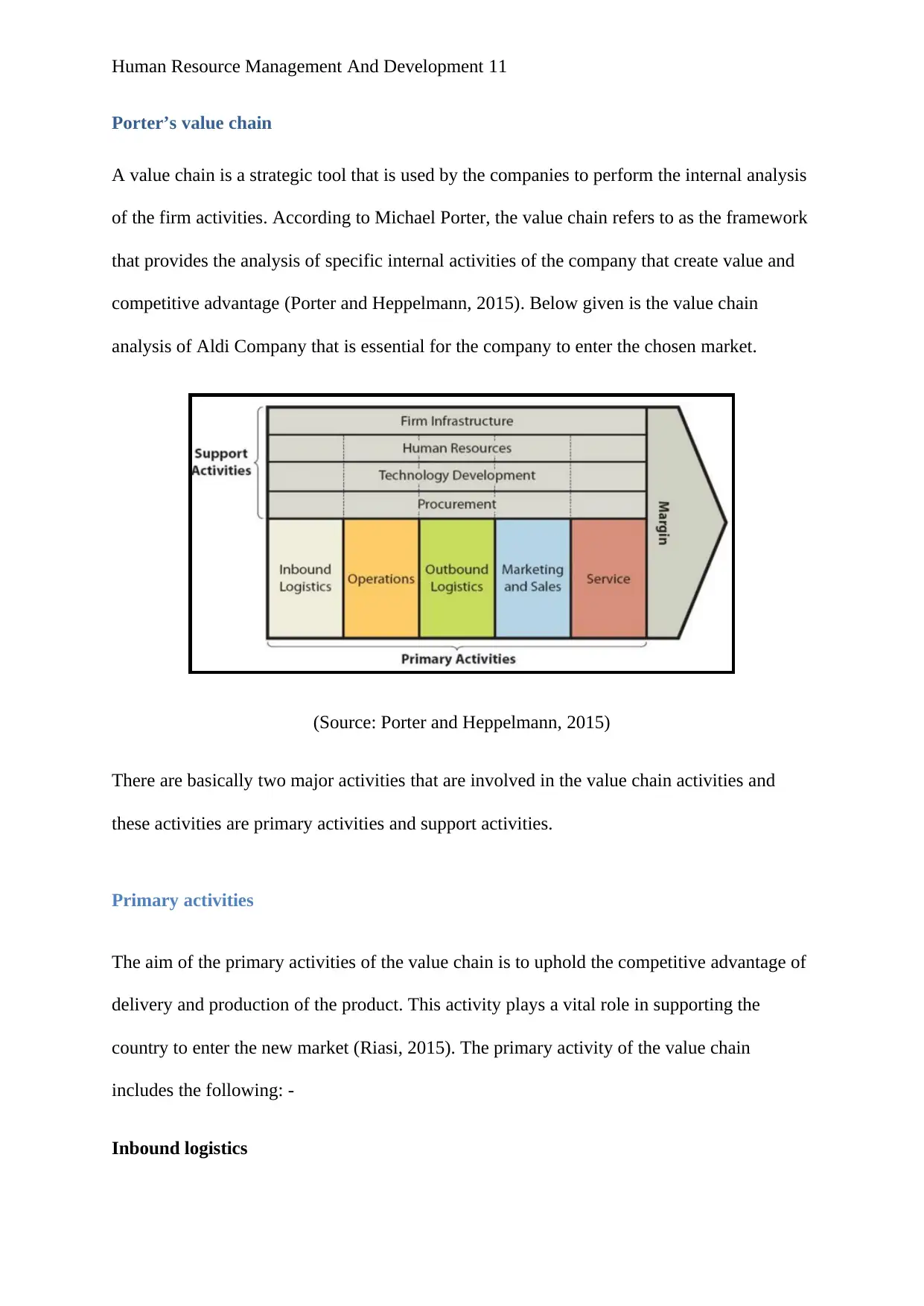
Human Resource Management And Development 11
Porter’s value chain
A value chain is a strategic tool that is used by the companies to perform the internal analysis
of the firm activities. According to Michael Porter, the value chain refers to as the framework
that provides the analysis of specific internal activities of the company that create value and
competitive advantage (Porter and Heppelmann, 2015). Below given is the value chain
analysis of Aldi Company that is essential for the company to enter the chosen market.
(Source: Porter and Heppelmann, 2015)
There are basically two major activities that are involved in the value chain activities and
these activities are primary activities and support activities.
Primary activities
The aim of the primary activities of the value chain is to uphold the competitive advantage of
delivery and production of the product. This activity plays a vital role in supporting the
country to enter the new market (Riasi, 2015). The primary activity of the value chain
includes the following: -
Inbound logistics
Porter’s value chain
A value chain is a strategic tool that is used by the companies to perform the internal analysis
of the firm activities. According to Michael Porter, the value chain refers to as the framework
that provides the analysis of specific internal activities of the company that create value and
competitive advantage (Porter and Heppelmann, 2015). Below given is the value chain
analysis of Aldi Company that is essential for the company to enter the chosen market.
(Source: Porter and Heppelmann, 2015)
There are basically two major activities that are involved in the value chain activities and
these activities are primary activities and support activities.
Primary activities
The aim of the primary activities of the value chain is to uphold the competitive advantage of
delivery and production of the product. This activity plays a vital role in supporting the
country to enter the new market (Riasi, 2015). The primary activity of the value chain
includes the following: -
Inbound logistics
⊘ This is a preview!⊘
Do you want full access?
Subscribe today to unlock all pages.

Trusted by 1+ million students worldwide
1 out of 27
Related Documents
Your All-in-One AI-Powered Toolkit for Academic Success.
+13062052269
info@desklib.com
Available 24*7 on WhatsApp / Email
![[object Object]](/_next/static/media/star-bottom.7253800d.svg)
Unlock your academic potential
Copyright © 2020–2025 A2Z Services. All Rights Reserved. Developed and managed by ZUCOL.




